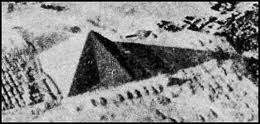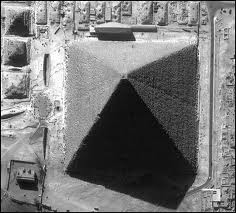I've been collecting images from across the internet of Egyptian stamps to get some ideas for the limited edition posters that are going to go with the pack. I love the way their laid out with thick boarders and two or more typefaces, one Eygptian arabic and one english. I think It would be really nice to produce some artwork in a similar style to correspond with our publication, I think the style of these stamps could work really well with the technique I've experimented with in laser cutting.
http://www.timstouse.com/EarthHistory/Egypt/GreatPyramid/interestingfacts.htm
Interesting facts about the 8 sides of a pyramid to use within y first test piece.
http://cassiopaea.org/forum/index.php?topic=27990.0
The Concave Faces of the Great Pyramid
Aerial photo by Groves, 1940 (detail).

In his book The Egyptian Pyramids: A Comprehensive, Illustrated Reference, J.P. Lepre wrote:
One very unusual feature of the Great Pyramid is a concavity of the core that makes the monument an eight-sided figure, rather than four-sided like every other Egyptian pyramid. That is to say, that its four sides are hollowed in or indented along their central lines, from base to peak. This concavity divides each of the apparent four sides in half, creating a very special and unusual eight-sided pyramid; and it is executed to such an extraordinary degree of precision as to enter the realm of the uncanny. For, viewed from any ground position or distance, this concavity is quite invisible to the naked eye. The hollowing-in can be noticed only from the air, and only at certain times of the day. This explains why virtually every available photograph of the Great Pyramid does not show the hollowing-in phenomenon, and why the concavity was never discovered until the age of aviation. It was discovered quite by accident in 1940, when a British Air Force pilot, P. Groves, was flying over the pyramid. He happened to notice the concavity and captured it in the now-famous photograph. [p. 65]
This strange feature was not first observed in 1940. It was illustrated in La Description de l'Egypte in the late 1700's (Volume V, pl. 8). Flinders Petrie noticed a hollowing in the core masonry in the center of each face and wrote that he "continually observed that the courses of the core had dips of as much as ½° to 1°" (The Pyramids and Temples of Gizeh, 1883, p. 421). Though it is apparently more easily observed from the air, the concavity is measurable and is visible from the ground under favorable lighting conditions.
Ikonos satellite image of the Great Pyramid.
Interesting facts about the 8 sides of a pyramid to use within y first test piece.
http://cassiopaea.org/forum/index.php?topic=27990.0
The Concave Faces of the Great Pyramid
Aerial photo by Groves, 1940 (detail).

In his book The Egyptian Pyramids: A Comprehensive, Illustrated Reference, J.P. Lepre wrote:
One very unusual feature of the Great Pyramid is a concavity of the core that makes the monument an eight-sided figure, rather than four-sided like every other Egyptian pyramid. That is to say, that its four sides are hollowed in or indented along their central lines, from base to peak. This concavity divides each of the apparent four sides in half, creating a very special and unusual eight-sided pyramid; and it is executed to such an extraordinary degree of precision as to enter the realm of the uncanny. For, viewed from any ground position or distance, this concavity is quite invisible to the naked eye. The hollowing-in can be noticed only from the air, and only at certain times of the day. This explains why virtually every available photograph of the Great Pyramid does not show the hollowing-in phenomenon, and why the concavity was never discovered until the age of aviation. It was discovered quite by accident in 1940, when a British Air Force pilot, P. Groves, was flying over the pyramid. He happened to notice the concavity and captured it in the now-famous photograph. [p. 65]
This strange feature was not first observed in 1940. It was illustrated in La Description de l'Egypte in the late 1700's (Volume V, pl. 8). Flinders Petrie noticed a hollowing in the core masonry in the center of each face and wrote that he "continually observed that the courses of the core had dips of as much as ½° to 1°" (The Pyramids and Temples of Gizeh, 1883, p. 421). Though it is apparently more easily observed from the air, the concavity is measurable and is visible from the ground under favorable lighting conditions.
Ikonos satellite image of the Great Pyramid.

I.E.S. Edwards wrote, "In the Great Pyramid the packing-blocks were laid in such a way that they sloped slightly inwards towards the centre of each course, with a result that a noticeable depression runs down the middle of each face -- a peculiarity shared, as far as is known, by no other pyramid" (The Pyramids of Egypt, 1975, p. 207). Maragioglio and Rinaldi described a similar concavity on the pyramid of Menkaure, the third pyramid at Giza. Miroslav Verner wrote that the faces of the Red Pyramid at Dahshur are also "slightly concave."
_______________________________________________________________________________
http://www.world-mysteries.com/mpl_2.htm - amazing link for source material
_______________________________________________________________________________
Below I've started to construct my own stamp on Illustrator working similar to the ones i've collected from around the internet. I thought the relief of a stamp could work really nicely in tying in with hieroglyphs and the cutting of pyramid walls. I've imitated the 1920's stamp with both Egyptian Arabic and English however the typeface i've used is called alhambra and is an imitation of an Arabic set of letters however it read english.
The artwork I',m started to produce is for the limited edition posters, promotional material and jigsaw puzzle. Each plaque is going to imitative a different style of stamp and each contain a different interesting set of facts about the pyramids. This particular one is going to be about the 8 sides of pyramid Khufu, a common mis-perception.
Below I've started to construct my own stamp on Illustrator working similar to the ones i've collected from around the internet. I thought the relief of a stamp could work really nicely in tying in with hieroglyphs and the cutting of pyramid walls. I've imitated the 1920's stamp with both Egyptian Arabic and English however the typeface i've used is called alhambra and is an imitation of an Arabic set of letters however it read english.
The artwork I',m started to produce is for the limited edition posters, promotional material and jigsaw puzzle. Each plaque is going to imitative a different style of stamp and each contain a different interesting set of facts about the pyramids. This particular one is going to be about the 8 sides of pyramid Khufu, a common mis-perception.







